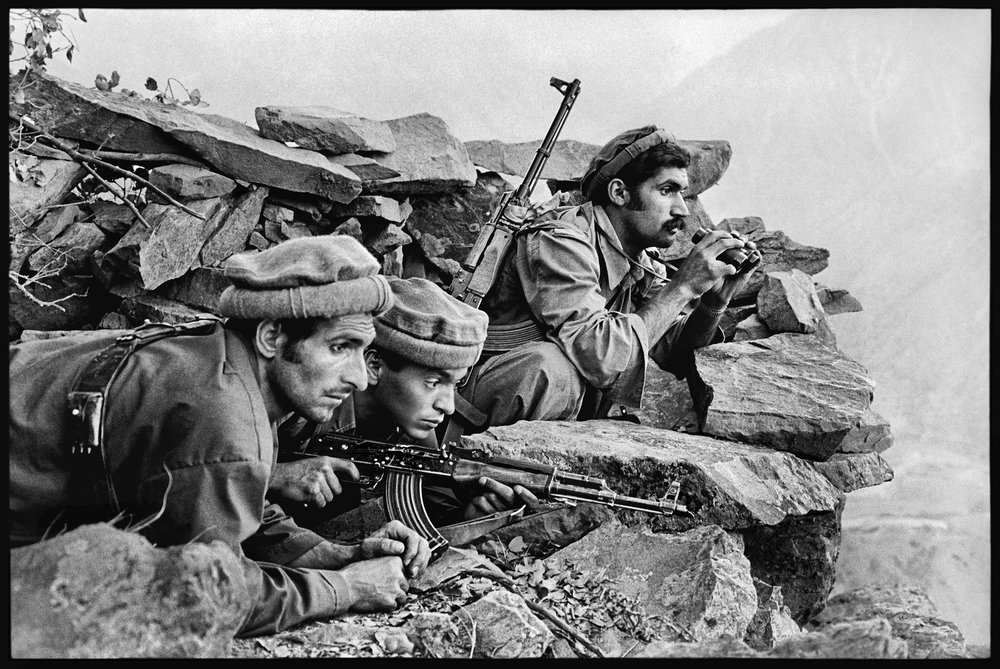Contemporary photo-journalist Steve McCurry’s famous photos capture cultural narratives, living heritage and war-torn regions. His most famous photo, The Afghan Girl, made the cover of National Geographic in June 1985.

Nuristan, Afghanistan 19979. Source: stevemccurry.com
Steve McCurry is an American photographer and photojournalist who built his career around his daring photo-journalism of armed conflict.
“The photograph is an undeniably powerful medium. Free from the constraints of language, and harnessing the unique qualities of a single moment frozen in time.” – Steve McCurry
Arguably the most iconic photographer working today, his incredible oeuvre encompasses some of the most powerful and recognized images of our time, showcasing the incredible diversity and beauty of our world.
Known for his legendary portrait ‘The Afghan Girl’, that featured on the cover of National Geographic in June 1985, Steve is a recognised photographer who immortalised the haunting gaze of Sharbat Gula, a refugee living in a camp near Peshawar, Pakistan. Her eyes spoke volumes of the suffering and resilience of the refugees, cementing McCurry’s reputation as a master storyteller through photography.
“There’s a contemplative or meditative quality to photography which I find to be a sort of peaceful state. I love being able to travel the world, and experience different cultures and landscapes,” he says.
The iconic ‘Sri Lankan Fishermen’ photograph of 1995 depicts the traditional stilt fishing practice in Weligama, Sri Lanka. The photographer’s simplicity belies its evocative power: fishermen perched precariously on slender wooden poles, casting their lines into the churning waters of the Indian Ocean. Steve’s composition captures a vanishing way of life.
Who is Steve McCurry?
Born in Philadelphia, Pennsylvania on April 23, 1950, McCurry, while majoring in cinematography and filmmaking at Pennsylvania State University, discovered his passion for still photography. McCurry’s break came in 1979 when he made a life-changing trip to India in the Seventies with little more than a bag of clothes and film, exploring the subcontinent with his camera.
Shortly after, McCurry crossed the border into Pakistan. In a small village, he met a group of refugees from Afghanistan, and sought their help in crossing the border into their country, just as the Russian invasion was closing the country to Western journalists. Emerging in traditional dress, with a full beard and weather-worn features after months embedded with the Mujahideen, McCurry smuggled his photographs out of Pakistan, sewn into his clothes.

McCurry’s photographs were among the first to show the world the brutality of the Russian invasion. Source: stevemccurry.com
Some of the first photographs to exhibit the conflict in Afghanistan, they won him the Robert Capa Gold Medal for Best Photographic Reporting from Abroad, an honor awarded to photographers exhibiting exceptional courage and enterprise.
Steve McCurry’s body of work has produced some of the most iconic images in the history of photography, capturing rich cultural narratives. For months, he lived among the Afghans, integrating himself with the Mujahideen and documenting their lives through his lens. He captured their struggles, resilience, and the harsh realities of war disguised in traditional attire and sporting a full beard. This audacious act marked the beginning of McCurry’s extraordinary photography career as a photojournalist. His bravery and empathy in capturing the human spirit have since become hallmarks of his work.
“I was covering the war that erupted between the militias after the Russians withdrew from Afghanistan, photographing the aftermath of an attack on Kabul when, without warning, another rocket attack began,” he says on his official website.
“I took cover in what turned out to be a hospital for the mentally ill. Its residents were the victims of more than a decade of war – both civilians and soldiers. There were no doctors or nurses, no electricity, no running water. The smoke from the fire of a makeshift kitchen had blackened the ceilings and walls. The men and women there wandered around, or sat in a catatonic stupor.”

Kandahar, Afghanistan, 1992. Source: stevemccurry.com
McCurry’s photographs were among the first to show the world the brutality of the Russian invasion. Since, his photographs span conflicts, vanishing cultures, ancient traditions and contemporary culture yet retains the human element.
In 2024, he added Alaska to his travels. McCurry sailed for a week aboard Silver Nova in Southeast Alaska and returned with photographs of Southeast artisans handcrafting products from trees; the Chugach mountain range that towers at 13,094 ft at Mount Marcus Baker; and the Hubbard Glacier, outside Yakutat. Its saltwater face stretches six miles, and the glacier itself is seventy-six miles long from its origin near Mount Logan in Canada’s Yukon Territory.
In addition to his photo-journalism, McCurry has also used his photography to advocate for social and environmental causes. His famous photos have raised awareness of important issues, such as the plight of refugees and the effects of climate change, inspiring viewers to take action and make a positive difference.
Steve McCurry famous photos
- The Afghan Girl, 1984

The Afghan Girl, 1984. Image Source: cnn.com
The Afghan Girl photograph is undoubtedly one of Steve McCurry’s most famous works. In 1984, while documenting the Soviet-Afghan War, McCurry found himself in Nasir Bagh camp1, where a girls’ school had been set up. Here, McCurry came across a class of fifteen girls. Among them, one stood out for her green eyes, which he could only describe as haunting and intense. Her name was Sharbat Gula. The moment McCurry’s lens captured the intensity of her gaze, a connection was forged and her eyes spoke volumes about her struggles and resilience.
McCurry’s mastery of composition is evident in The Afghan Girl. The unwavering stare of Sharbat Gula draws viewers in, inviting them to witness her story and the turbulent backdrop of her life as a refugee. The background, though blurred, provides context to the setting without overpowering the subject, allowing Gula to remain the focal point of the photograph.
The Afghan Girl graced the cover of National Geographic in June 1985, propelling McCurry to international acclaim. “I knew she had an incredible look, a penetrating gaze,” he told CNN. “But there was a crowd of people around us, the dust was swirling around, and it was before digital cameras and you never knew what would happen with the film. When I developed the picture, I knew it was special. I showed it to the editor of the National Geographic, and he leaped to his feet and shouted, ‘that’s our next cover’.”
- Sri Lankan Fishermen, 1995
In 1995, Steve McCurry captured an extraordinary moment of everyday life in Weligama, Sri Lanka. The photograph shows the traditional stilt fishing method employed by fishermen in the region. The composition of this photograph is simple yet breathtaking. Perched on wooden stilts, the fishermen cast their lines into the Indian Ocean below. The agitated waters and the fishermen’s precarious positions create a captivating visual narrative, portraying the difficulty of this vanishing fishing tradition.
- Shaolin Monastery, 2004
Steve McCurry’s 2004 photograph taken at the Shaolin Monastery in Hunan Province, China, captures the essence of martial arts, spiritual discipline, and the playfulness of the human spirit. The photograph features young Shaolin monks, dressed in traditional orange robes while performing different activities. The focal point of the photograph is a monk, captured mid-air as he bounces off a wall above others. The monk’s precise and focused movements are frozen in time, while the surrounding architecture and natural elements add depth and context to the photograph, which has since been widely celebrated for its portrayal of the ancient art of Kung Fu.
- Camels Under a Blackened Sky, 1991
Camels Under a Blackened Sky is a captivating photograph taken by Steve McCurry during the aftermath of the Gulf War in 1991. The photograph is a poignant overview of the devastating environmental and human impact of the conflict on the nation of Kuwait.
In the wake of the Gulf War, Kuwait was left grappling with the aftermath of the Iraqi invasion and the subsequent retaking of the country by coalition forces. During this tumultuous period, retreating Iraqi troops engaged in a scorched-earth policy, igniting hundreds of oil wells across Kuwait. These oil fires created apocalyptic scenes of blackened skies and billowing smoke that engulfed the landscape. Against this surreal backdrop, McCurry came across a remarkable scene featuring a group of camels traversing the scorched terrain. The juxtaposition of the stoic camels against the ominous blackened sky creates a sense of surreal beauty tinged with tragedy.
Camels Under a Blackened Sky not only highlights the environmental devastation caused by the oil fires but also serves as a symbolic representation of hope and endurance amidst the ravages of war. The photograph has been widely celebrated for its artistic composition and the poignant message it conveys about the impact of conflict on both the natural world and the beings that inhabit it.
- Man at the Holi Festival in Rajasthan, 1996
This photograph of a man at the Holi Festival in Rajasthan is a mesmerising photograph captured by Steve McCurry during Holi. The image perfectly encapsulates the joy and spirit of this ancient Hindu festival, which marks the arrival of spring and the triumph of good over evil. In the photograph, we see a jubilant man covered in vibrant colour from head to toe, partaking in the revelry that characterises the festival. McCurry’s keen eye for capturing the essence of human emotions is evident in this photograph. Against a backdrop of vivid colors and fellow festival-goers covered in red powder, the man stands as a vibrant focal point. And, the photograph beautifully captures the dynamism and energy of the festival.
The work transcends being merely a photograph of a festive event. It becomes a portal to the heart of a cultural celebration, inviting viewers to partake in the contagious delight of Holi and the sense of unity and joy that it brings to this community. This photograph has been widely celebrated and exhibited, cementing its place as one of Steve McCurry’s most iconic works. It serves as a vivid reminder of the universal power of celebration and the shared experience of joy that unites people from diverse backgrounds and cultures.
Awards and Recognition

Afghanistan, 1979. Source: www.stevemccurry.com
McCurry has been recognised with the most prestigious accolades and achievements, including the Robert Capa Gold Medal for Best Photographic Reporting from Abroad for photographs that captured the haunting realism of the armed conflict in Pakistan.
McCurry has been named The National Press Photographers Association’s Magazine Photographer of the Year and he has earned the Oliver Rebbot Memorial Award twice. Additionally, he has been honoured with Royal Photographic Society’s Centenary Medal for Lifetime Achievement and McCurry was inducted into the International Photography Hall of Fame.
McCurry has photographed the Iran-Iraq War, Beirut, Cambodia, the Philippines, the Gulf War and the strife in Afghanistan. His work has been featured in major magazines including National Geographic. He is recognised for risking his life to capture images from the front lines. A career high point was undoubtedly the National Geographic cover photo of the Afghan refugee girl, described as the most recognizable photograph in the world today.
Per Magnum Photos, he says, ”What is important to my work is the individual picture. I photograph stories on assignment, and of course they have to be put together coherently. But what matters most is that each picture stands on its own, with its own place and feeling.”
McCurry has published five books: The Imperial Way (1985), Monsoon (1988), Portraits (1999), and South Southeast published in the fall of 2000 and first-prize winner in the book category of the Pictures of the Year competition. Sanctuary (2002), is an exploration of the temples of Angkor Wat in Cambodia. The Path to Buddha: Tibetan Pilgrimage was published this year.
Five Things You Might Not Know About Steve McCurry

Nuristan, Afghanistan 1980. Image: www.stevemccurry.com
- Before becoming a celebrated photographer, Steve McCurry started his career as as a photojournalist for a local newspaper in Pennsylvania. This job shaped his ability to tell compelling stories through images.
- In 1979, Steve McCurry disguised himself in traditional clothing and crossed the border into Afghanistan during the Soviet invasion. His images from this dangerous journey, smuggled out in his clothing, brought global attention to the conflict and launched his international career.
- The iconic “Afghan Girl” photograph, featured on the cover of National Geographic in 1985, was almost lost. McCurry’s film rolls were nearly destroyed during his Afghanistan expedition due to the harsh conditions and conflicts he faced.
- Despite the rise of digital technology, McCurry has a deep love for film photography. He often shoots Kodachrome film and was one of the last photographers to use it before it was discontinued.
- McCurry has faced criticism for digitally altering some of his photographs, sparking debates about ethics in photojournalism. Despite the controversy, he defends his approach, saying his work straddles the line between journalism and art.
Jasmeen Dugal is Associate Editor at FashionABC, contributing her insights on fashion, technology, and sustainability. She brings with herself more than two decades of editorial experience, working for national newspapers and luxury magazines in India.
Jasmeen Dugal has worked with exchange4media as a senior writer contributing articles on the country’s advertising and marketing movements, and then with Condenast India as Net Editor where she helmed Vogue India’s official website in terms of design, layout and daily content. Besides this, she is also an entrepreneur running her own luxury portal, Explosivefashion, which highlights the latest in luxury fashion and hospitality.








